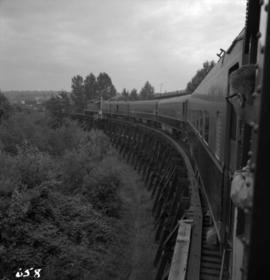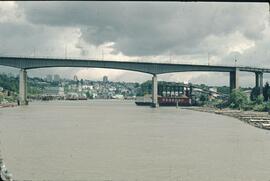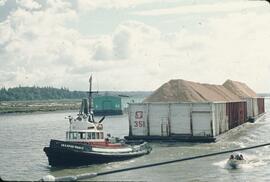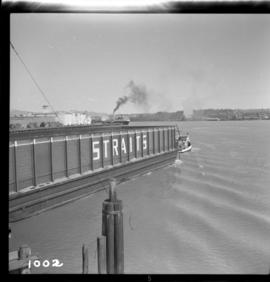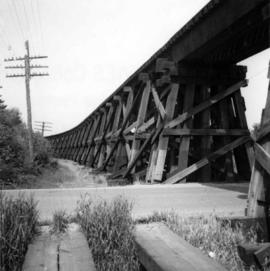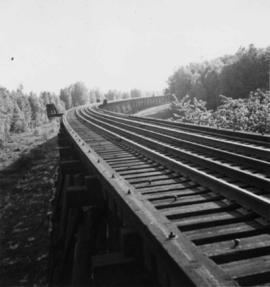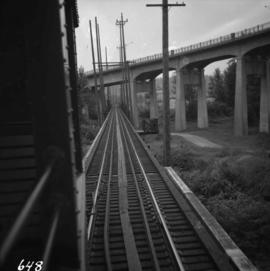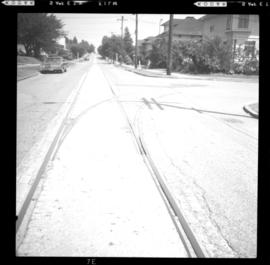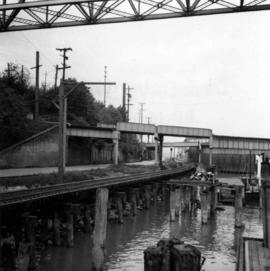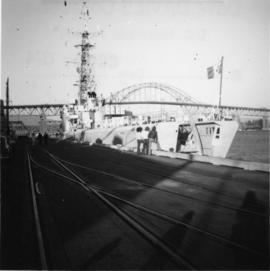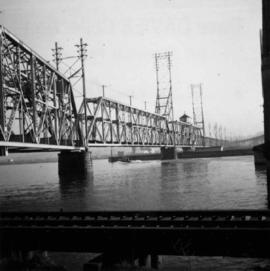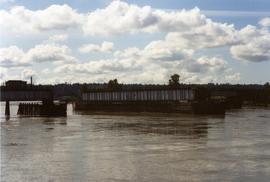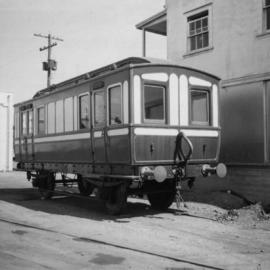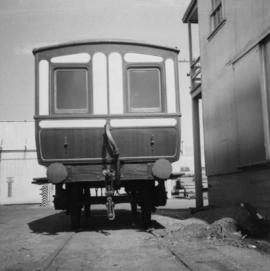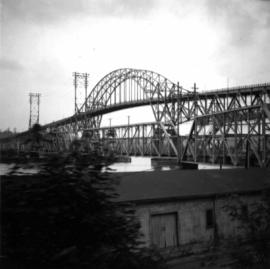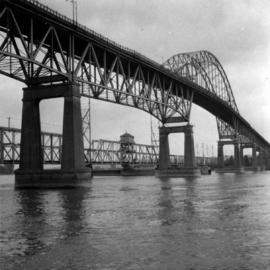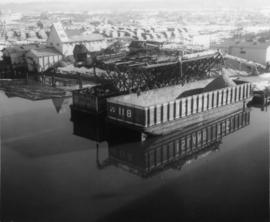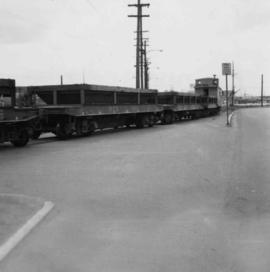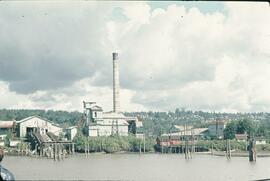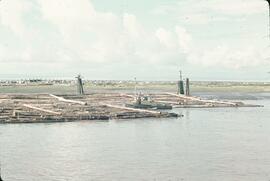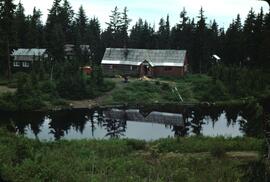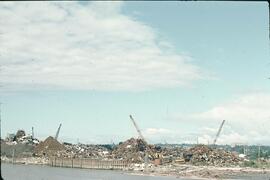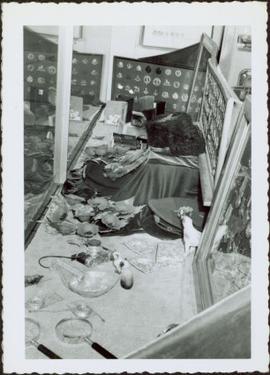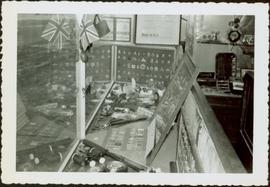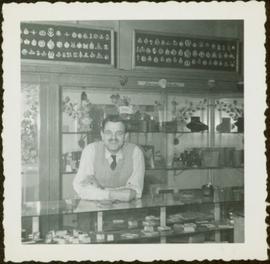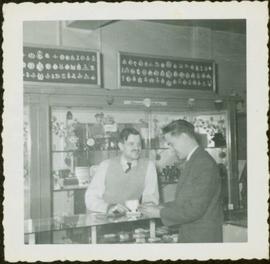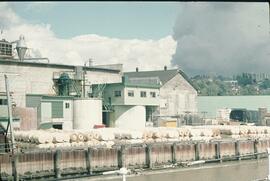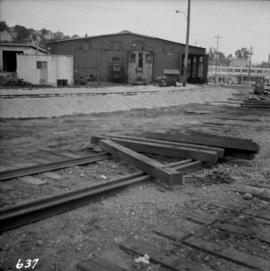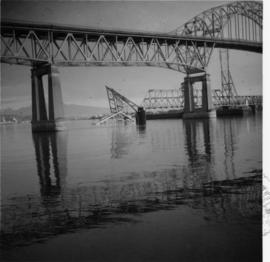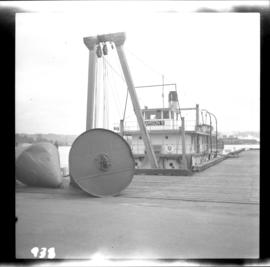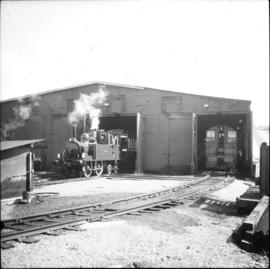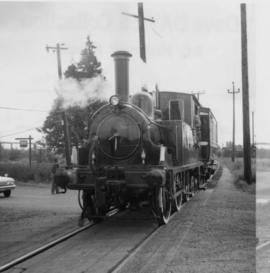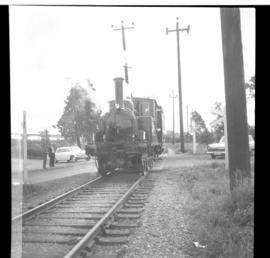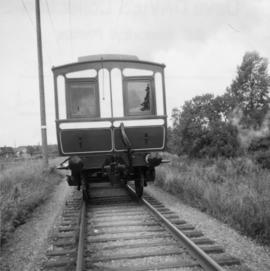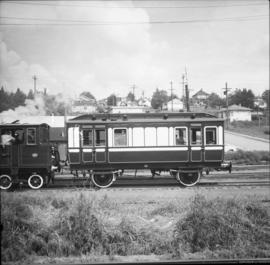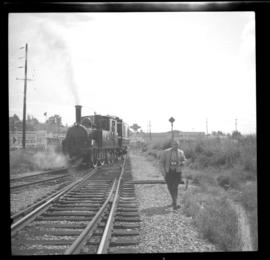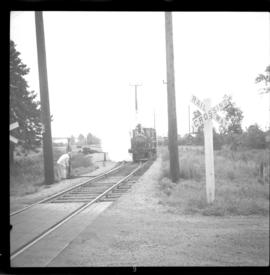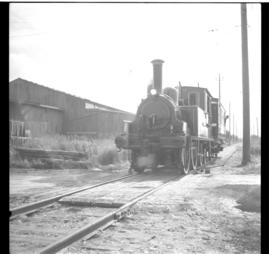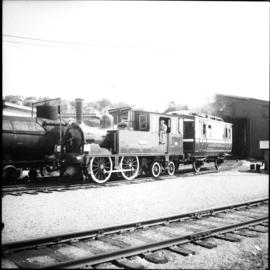Photograph depicts the West Coast Railway Association special on the Canadian National Railway (CN) trestle, immediately south of the Fraser River bridge at New Westminster, travelling east.
New Westminster, BC
85 Archival description results for New Westminster, BC
Photograph depicts the tugboat "Gulf Margaret" with a Straits scow leaving the north arm of the Fraser River and entering the main river at New Westminster, travelling upstream. The tug belongs to the Gulf of Georgia Towing Company.
Photograph depicts a small tugboat rescuing a motor cruiser that had been swept downstream in the Annacis Channel against a bridge, about 1.5 miles southwest of the Patullo Bridge, New Westminster.
Photograph depicts a trestle of the Great Northern Railway, main line to Blaine, curving towards the southwest from the south end of the New Westminster rail bridge.
Photograph depicts a trestle on the south bank of the north arm of the Fraser River leading from the C.N.R. swing bridge, approximately 5 miles southeast of New Westminster, looking south.
Photograph depicts three B.C. Electric Railway locomotives on running line to the west of car barn at New Westminster.
Photograph depicts the split of the Great Northern Railway (GNR) (shown) and the Canadian National Railway (CN) tracks, immediately south of the Fraser crossing at New Westminster.
Photograph depicts former street car tracks in New Westminster.
Photograph depicts the road and rail bridges at New Westminster, BCView is from the north and facing upstream.
Photograph depicts RCN "Restigouche," a destroyer escort that was fitted to eliminate submarines. It towed a 7 ton sonar pod and had 8 torpedoes that were launched by rockets. It was first initiated in 1954. Canada, at the time, had 4 ships of this class.
File consists of documentary photographs taken by David Davies of the railway preservation of the "Dunrobin" locomotive in British Columbia.
Photograph depicts the railway bridge at New Westminster, looking towards the south bank. The bridge is used by C.N., BCHydro, and the Great Northern Railway.
Photograph depicts railway track previously owned by BCER. It led onto the east end of Lulu Island and then to Annacis Island. Looking from the Naew West River Walk to the Queensborough bridge that was protected by signals and had a high chain link fence to deter pedestrians. It was likely that the rail was only used at night. Originally built by Canadian Northern Railway to reach Steveston, circa 1917.
Map depicts the proposed electoral districts of British Columbia, including: Burnaby, Capilano, Cariboo-Chilcotin, Comox-Powell River, Cowichan-Malahat-The Islands, Esquimalt-Saanich, Fort Nelson-Peace River, Fraser Valley East, Fraser Valley West, Kamloops-Shuswap, Kootenay East, Kootenay West, Mission-Port Moody, Nanaimo-Alberni, New Westminster-Coquitlam, North Vancouver-Burnaby, Okanagan North, Okanagan-Similkameen, Prince George-Bulkley Valley, Richmond-South Delta, Skeena, Surrey-White Rock-North Delta, Vancouver Centre, Vancouver East, Vancouver Kingsway, Vancouver Quadra, Vancouver South, and Victoria.
Photograph depicts a four-wheeled private saloon coach #58A, built in 1909 at Lochgorm Works (of Highland Railway) in Inverness, Scotland. It is the property of the provincial government of B.C. and located in the dock area of New Westminster. The wheels have solid wooden pieces between axels and tires.
Photograph depicts the end view of the four-wheeled private saloon coach #58A, built in Inverness in 1909 and formerly the property of the Duke of Sutherland. It is owned by the B.C. provincial government and is standing at the New Westminster docks.
Photograph depicts the rail connections below the north bank of the Patullo Bridge in New Westminster. The track in the foreground belongs to C.N. and the flyover foreground rail bridge belongs to the B.C. Electric Railway. The flyover background rail bridge is shared by the Great Northern Rail and C.N. Rail.
Photograph depicts the Patullo Bridge in New Westminster, looking east with the rail bridge in the background.
Photograph taken on the north arm of the Fraser River. Looking southeast from Queensborough Bridge to the north end of Wood Street.
Photograph depicts mixed freight with 5 ballast cars at the rear, running east through the former New Westminster depot, which is just to the left of the photo. The view is looking southwest.
This file consists of 79 photographs, various postcards and Christmas cards from the Royal Irish Constabulary; “Old Hand remembers early days” (unidentified newspaper article re: Burnaby detachment of BC Provincial Police); and a magazine clipping featuring a group photo of “Officers of the B.C. Police, April 1930.” General subjects areas identified in the photographs include: Toc H (Kelowna); the Royal Irish Constabulary; the British Columbia Provincial Police; the Royal Canadian Mounted Police; 1945 liberation parade in Amsterdam, Holland; various historical regimental artworks; badges, helmets, ornaments, banners and related constabulary ephemera; and Claxton in his New Westminster store "Roderick Jewelers" with his extensive collection of constabulary related materials.
Photograph depicts four frames of James Joseph Claxton's military badge collection in a window display with ceramics, magnifying glasses, and military hats included in the window case. Handwritten annotation on verso reads: “Nov 11th Window 1951 Roderick Jewellers Part of JJC’s badge collection.”
Photograph depicts a window display at Roderick Jewelers with military badges and medals on display in the case. Handwritten annotation on verso reads: “Roderick Jewellers 1951 Nov 11th window. Part of JJC’s badge collection.”
Collection consists of 140 photographs pertaining to the life and pursuits of James Joseph Claxton over the course of sixty years. Subject areas identified within this collection include: quartz and placer mining in the Cariboo; Kingcome Village; the Royal Irish Contabulary; Roderick's Jewelers, New Westminster; the "M.S. Columbia III"; Kwakiutl petrographs in Fort Rupert; totem poles at Alert Bay; and the Salmon Arm Boy Scouts of Canada group.
Claxton, James JosephPhotograph depicts James Joseph Claxton is leaning on the on the store counter with his framed badge collection is visible on the wall behind him. Handwritten annotation on verso reads: “Part of JJC’s badge collection. Roderick Jewelers N. West 1954.”
Photograph depicts James Joseph Claxton’s framed badge collection visible on the wall behind the store counter. Handwritten annotation on verso reads: “Part of JJC’s Collection of badges 1954 Rodericks’ Jeweler’s New West.”
Photograph depicts a Great Northern Railway freight train travelling south over trestle at the south end of a New Westminster rail bridge, at the point where the Great Northern Railway tracks swings westward.
Photograph depicts Great Northern Railway freight heading south having just come off of the New Westminster government rail bridge.
Photograph depicts a former car barn of the B.C. Electric Railway at New Westminster. Newly aligned track to doors (from left) #3 and #5.
Photograph depicts the Federal Railway Bridge in New Westminster. It had been knocked down by a runaway scow. The new span was to be built and installed by April 22, 1976.
Photograph depicts the Federal Railway Bridge in New Westminster. Its span had been knocked down by an unmanned scow. New span was to be floated in on by April 22, 1976.
Photograph depicts the federal government paddle steam sternwheeler "Samson V" at New Westminster. It is used daily on the Fraser River to lift and move buoys etc. It was built in 1937 at New Westminster. It operates between the mouth of the Fraser and Mission. Its crew of 10 is made up of a captain, mate, bosun, two deckhands, cook, steward, chief engineer, greaser, and engineer. It is kept in excellent shape, inside and out.
Photograph depicts the federal government paddle steam sternwheeler "Samson V" at New Westminster. The boiler room is the fore part of the lower deck.
Photograph depicts the stern wheel of the federal government steamer "Samson V," tied up at New Westminster.
Photograph depicts a British locomotive, the "Dunrobin," as well as a saloon coach found at a BCER locomotive shed. It was emerging for a second trial run to Steveston. It just underwent a complete overhaul in 1966 after being being purchased by the provincial government of British Columbia.
Photograph depicts a British locomotive, the "Dunrobin, " and a saloon coach beginning a test run on BCER track between New West Minster and Marpole.
Photograph depicts a British locomotive, the "Dunrobin, " and a saloon coach beginning a test run on BCER track between New West Minster and Marpole.
Photograph depicts a British locomotive, the "Dunrobin" and a saloon coach on a test run at the BCER track between New Westminster and Marpole. The train was forced to stop because of working going on along the line 200 yards behind the camera.
Photograph depicts a British locomotive, the "Dunrobin, " and a saloon coach on a test run between New Westminster and Steveston on BCER track beside the Rayonier lumber mill (which was consumed by fire in 1966).
Photograph depicts a British locomotive, the "Dunrobin, " and a saloon coach on BCER track in New Westminster. It was on its second steaming trial since the 1940's.
Photograph depicts a British locomotive, the "Dunrobin, " and a saloon coach on BCER track in New West Minster, facing Marpole. The locomotive had stopped and was waiting for the loop switch to be turned.
Photograph depicts a British locomotive, the "Dunrobin, " and a saloon coach beginning a test run on BCER track between New West Minster and Marpole.
Photograph depicts a British locomotive, the "Dunrobin," as well as a saloon coach found at a BCER locomotive shed. It was emerging for a second trial run to Steveston. It just underwent a complete overhaul in 1966 after being being purchased by the provincial government of British Columbia.
